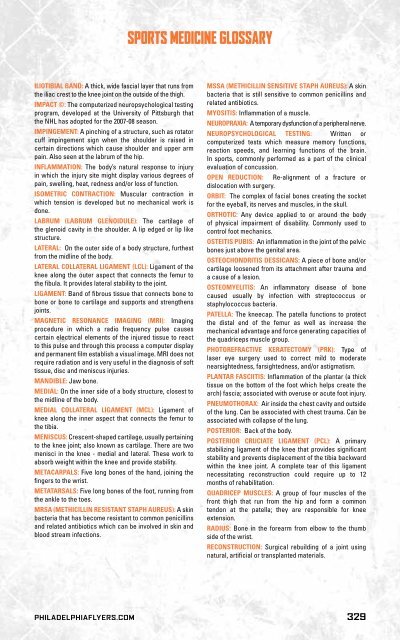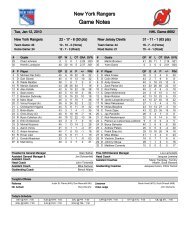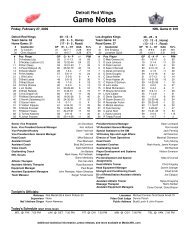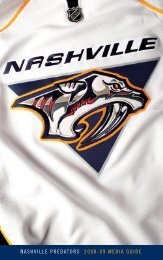flyers media guide - Philadelphia Flyers
flyers media guide - Philadelphia Flyers
flyers media guide - Philadelphia Flyers
Create successful ePaper yourself
Turn your PDF publications into a flip-book with our unique Google optimized e-Paper software.
Sports medicine Glossary<br />
Iliotibial Band: A thick, wide fascial layer that runs from<br />
the iliac crest to the knee joint on the outside of the thigh.<br />
ImPACT ©: The computerized neuropsychological testing<br />
program, developed at the University of Pittsburgh that<br />
the NHL has adopted for the 2007-08 season.<br />
Impingement: A pinching of a structure, such as rotator<br />
cuff impingement sign when the shoulder is raised in<br />
certain directions which cause shoulder and upper arm<br />
pain. Also seen at the labrum of the hip.<br />
Inflammation: The body’s natural response to injury<br />
in which the injury site might display various degrees of<br />
pain, swelling, heat, redness and/or loss of function.<br />
Isometric Contraction: Muscular contraction in<br />
which tension is developed but no mechanical work is<br />
done.<br />
Labrum (Labrum Glenoidule): The cartilage of<br />
the glenoid cavity in the shoulder. A lip edged or lip like<br />
structure.<br />
Lateral: On the outer side of a body structure, furthest<br />
from the midline of the body.<br />
Lateral Collateral Ligament (LCL): Ligament of the<br />
knee along the outer aspect that connects the femur to<br />
the fibula. It provides lateral stability to the joint.<br />
Ligament: Band of fibrous tissue that connects bone to<br />
bone or bone to cartilage and supports and strengthens<br />
joints.<br />
Magnetic Resonance Imaging (MRI): Imaging<br />
procedure in which a radio frequency pulse causes<br />
certain electrical elements of the injured tissue to react<br />
to this pulse and through this process a computer display<br />
and permanent film establish a visual image. MRI does not<br />
require radiation and is very useful in the diagnosis of soft<br />
tissue, disc and meniscus injuries.<br />
Mandible: Jaw bone.<br />
Medial: On the inner side of a body structure, closest to<br />
the midline of the body.<br />
Medial Collateral Ligament (MCL): Ligament of<br />
knee along the inner aspect that connects the femur to<br />
the tibia.<br />
Meniscus: Crescent-shaped cartilage, usually pertaining<br />
to the knee joint; also known as cartilage. There are two<br />
menisci in the knee - <strong>media</strong>l and lateral. These work to<br />
absorb weight within the knee and provide stability.<br />
Metacarpals: Five long bones of the hand, joining the<br />
fingers to the wrist.<br />
Metatarsals: Five long bones of the foot, running from<br />
the ankle to the toes.<br />
MRSA (Methicillin Resistant Staph Aureus): A skin<br />
bacteria that has become resistant to common penicillins<br />
and related antibiotics which can be involved in skin and<br />
blood stream infections.<br />
MSSA (Methicillin Sensitive Staph Aureus): A skin<br />
bacteria that is still sensitive to common penicillins and<br />
related antibiotics.<br />
Myositis: Inflammation of a muscle.<br />
Neuropraxia: A temporary dysfunction of a peripheral nerve.<br />
Neuropsychological Testing: Written or<br />
computerized tests which measure memory functions,<br />
reaction speeds, and learning functions of the brain.<br />
In sports, commonly performed as a part of the clinical<br />
evaluation of concussion.<br />
Open Reduction: Re-alignment of a fracture or<br />
dislocation with surgery.<br />
Orbit: The complex of facial bones creating the socket<br />
for the eyeball, its nerves and muscles, in the skull.<br />
Orthotic: Any device applied to or around the body<br />
of physical impairment of disability. Commonly used to<br />
control foot mechanics.<br />
Osteitis pubis: An inflammation in the joint of the pelvic<br />
bones just above the genital area.<br />
Osteochondritis Dessicans: A piece of bone and/or<br />
cartilage loosened from its attachment after trauma and<br />
a cause of a lesion.<br />
Osteomyelitis: An inflammatory disease of bone<br />
caused usually by infection with streptococcus or<br />
staphylococcus bacteria.<br />
Patella: The kneecap. The patella functions to protect<br />
the distal end of the femur as well as increase the<br />
mechanical advantage and force generating capacities of<br />
the quadriceps muscle group.<br />
Photorefractive Keratectomy (PRK): Type of<br />
laser eye surgery used to correct mild to moderate<br />
nearsightedness, farsightedness, and/or astigmatism.<br />
Plantar Fasciitis: Inflammation of the plantar (a thick<br />
tissue on the bottom of the foot which helps create the<br />
arch) fascia; associated with overuse or acute foot injury.<br />
Pneumothorax: Air inside the chest cavity and outside<br />
of the lung. Can be associated with chest trauma. Can be<br />
associated with collapse of the lung.<br />
Posterior: Back of the body.<br />
Posterior Cruciate Ligament (PCL): A primary<br />
stabilizing ligament of the knee that provides significant<br />
stability and prevents displacement of the tibia backward<br />
within the knee joint. A complete tear of this ligament<br />
necessitating reconstruction could require up to 12<br />
months of rehabilitation.<br />
Quadricep Muscles: A group of four muscles of the<br />
front thigh that run from the hip and form a common<br />
tendon at the patella; they are responsible for knee<br />
extension.<br />
Radius: Bone in the forearm from elbow to the thumb<br />
side of the wrist.<br />
Reconstruction: Surgical rebuilding of a joint using<br />
natural, artificial or transplanted materials.<br />
<strong>Philadelphia</strong><strong>Flyers</strong>.com 329

















